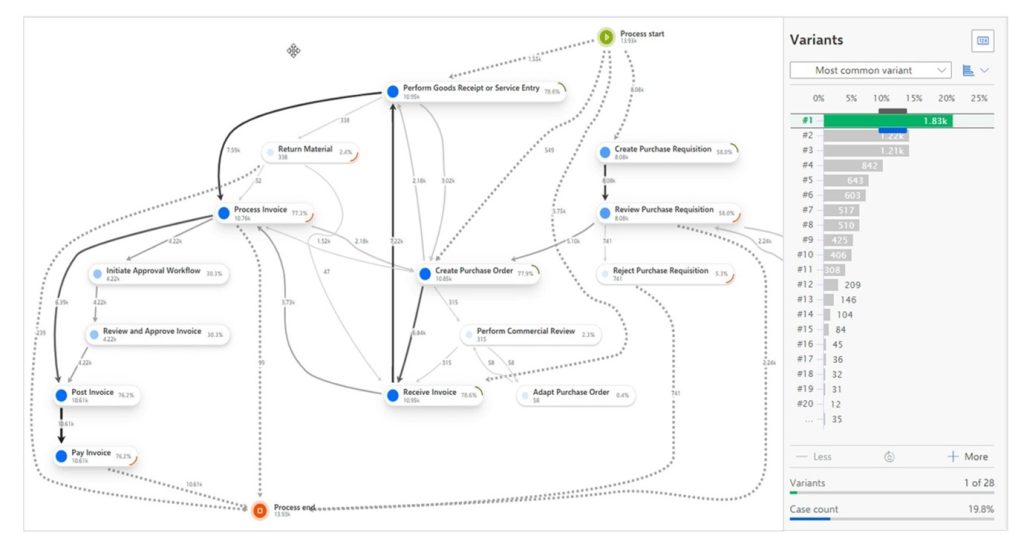Why process mining has reached the tipping point
Read why process mining is reaching the tipping point where it is indispensable for process-driven enterprises.

Process mining, which analyzes the execution of business processes to identify vulnerabilities, is reaching the tipping point where it is indispensable for process-driven enterprises.
Process mining is based on the approach of reconstructing the structure of each process instance from transaction data that is extracted from IT systems. These actual processes can be visualized as individual instances with process executions aggregated and filtered according to any criteria. All metrics relevant to process performance in terms of time, cost and quality are measured.
So, what are the success factors that are pushing this technology to tipping point? Its success is based mainly on the following aspects:
- Process mining enables the analysis of processes across system boundaries, i.e., with interrelated process sections that are executed in different IT systems, reconstructed and visualized as end-to-end processes.
- As a result of increasing process automation, significantly more analyzable data is available than was the case years ago. Online sales processes now provide data on all relevant customer touchpoints.
- The generation and visualization of actual processes and the analyses based on them are automated without manual effort (automated process discovery)
- In contrast to classic business intelligence systems, the analysis goes far beyond the calculation of metrics with key figures indicating problems as the “tip of the iceberg.” Actual root cause analysis performed by looking at the structure of the actual processes, since the greatest optimization potential usually lies in the elimination of unnecessary loops, complicated special cases and too many process variants.
- The automated analysis of variants provides a significant contribution to the elimination of quality, cost, or lead time problems (see the picture, which illustrates the recognition and analysis of process variants).

- As important as the standardization of processes is in terms of cost optimization, it is also important to provide personalized products and services to succeed in many industries (e.g., special credit cards or loan offers in financial companies). This individualization can only be achieved by automating processes and permanently monitoring and analyzing all process variants.
- Root-cause mining and machine-learning algorithms make it possible to identify weak points in the process, determining the influencing factors and their combinations. Current research aims to shorten the training phase of the algorithms and to identify not only correlations but real causalities in the (process) data.
- The range of scenarios for process analysis has expanded significantly: While in earlier years, the focus was on “classic” processes such as order-to-cash and purchase-to-pay, companies are now also using process mining to optimize production-related processes, linking IT data with OT (operational technology) data.
- Competitive success is increasingly based on operational excellence and less on the pure quality of products. Many business models are based on superior mastery of processes (e.g., quick commerce, fulfillment services of sales platforms). Customer loyalty can only be ensured through process excellence.
- Process management per se is based on an optimization cycle (Transform – Optimize – Control). Process mining results can now be used to automatically simulate what-if scenarios and derive optimization proposals, i.e., the BPM life cycle is completely closed.
Optimization
When it comes to the question of which aspects are optimized on this basis, a distinction can be made between three categories:
- Internally, the focus is on efficiency issues, i.e., the analysis of cost (often in connection with processing times), but also the quality of the results along a process, since poor quality or negative check results often trigger multiple processing (and further cost).
- All aspects that influence customer satisfaction are of interest (e.g., reaction and throughput times in service or support processes). Even more relevant is the detection and elimination of outliers, which – even if they occur rarely – have a massive negative impact on cost and customer satisfaction.
- In many industries, regulatory requirements are increasing sharply, so risk and compliance analysis plays a major role as a third category. With an automated monitoring system, controls are integrated into process handling, and it is ensured that specifications regarding quality, data protection and risk management are adhered to for each individual processing operation or that deviations are detected automatically.
Process mining has become widespread and the tipping point to where it becomes imperative is just around the corner.
In my next post, I will explain which further developments are going to make the technology even more indispensable in the future.
Read below for more information about ARIS Process Mining and what it can do for your organization.
This post originally appeared in OPEX.